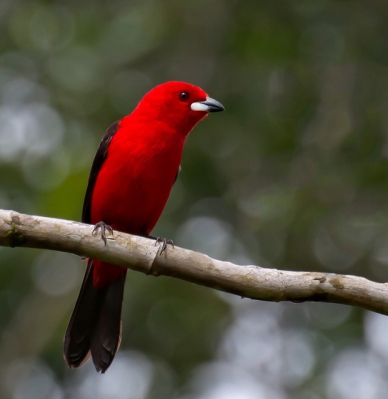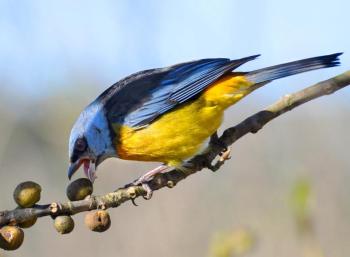But now ask the beasts, and they will teach you; And the birds of the air, and they will tell you; (Job 12:7 NKJV)
I have been busy trying to find photos for the Thraupidae – Tanagers and Allies Family page. The Tanagers are one of Passeriformes (Song Bird) Order. Working on this page and an upcoming series has kept me from writing as many articles.
But, Wow! Tanagers are some very neat birds that are found throughout the Americas; North, Central, and South (60% of them). Some are plain, but many are very colorful. At the present time with the IOC’s Version 2.10 of the Birds of the World list, there are 388 species in the Traupidae family. Needless to say, that is taking me some time to find the photos and then to load them to the site or provide links for the ones that I do not have permission for. I have gotten down to the Diglossa genus of Flowerpiercers. (which is a little past half way) I am trying to find as many of the supspecies also and that is where a lot of time is getting spent.
The Internet Bird Collection has one of the best collections that list the supspecies. It is a tremendous site that I use quite frequently. As of today, 12/6/2011, they have 56,387 videos, 51,697 photos and 6859 sounds of birds. That represents about 88.67% of all species. When I have problems finding a photo, this place will have it most likely.
Known to God from eternity are all His works. (Acts 15:18 NKJV)
Back to the tanagers. The family is in flux and some members have been moved to other families, but most are still in the Thraupidae family which has not only Tanagers, but also Hemispingus, Shrike-Tanagers, Mountain Tanagers, Dacnis, Honeycreepers, Conebills, Flowerpiercers, Bush Tanagers, Finches, Reed Finch, Island Finch, Diuca Finch, Inca Finch, Warbling Finch, Grassquit and Orangequits, Seedeaters, Seed Finch, Bullfinch, Ground Finch, Ant Tanagers, Chat-Tanagers, Spindalis and a Plushcap.
Tanagers are small to medium-sized birds. The shortest-bodied species, the White-eared Conebill, is 9 cm (3.8 in) long and weighs 7 grams, barely smaller than the Short-billed Honeycreeper. The longest, the Magpie Tanager is 28 cm (11 in) and weighs 76 grams (2.7 oz). The heaviest is the White-capped Tanager which weighs 114 grams (4 oz) and measures about 24 cm (9.5 in). Both sexes are usually the same size and weight. Tanagers are often brightly colored, but some species are black and white. Birds in their first year are often duller or a different color altogether. Males are typically more brightly coloured than females.
Most tanagers have short, rounded wings. The shape of the bill seems to be linked to the species’ foraging habits, which shows forethought and design by their Creator.
Most tanagers live in pairs or in small groups of 3-5 individuals. These groups may consist simply of parents and their offspring. Birds may also be seen in single species or mixed flocks. Many tanagers are thought to have dull songs, though some are elaborate.
Tanagers are omnivorous, and their diet varies from genus to genus. They have been seen eating fruits, seeds, nectar, flower parts and insects. Many pick insects off branches. Other species look for insects on the underside of leaves. Yet others wait on branches until they see a flying insect and catch it in the air. Many of these particular species inhabit the same areas, but these specializations alleviate competition.
The breeding season begin in March through until June in temperate areas and in September through October in South America. Some species are territorial while others build their nests closer together. There is little information on tanager breeding behavior or whether they are monogamous or polygamous. Males show off their brightest feathers to potential mates and rival males. Some species’ courtship rituals involve bowing and tail lifting.
Most tanagers build cup nests on branches in trees. Some nests are almost globular. Entrances are usually built on the side of the nest. The nests can be shallow or deep. The species of the tree they choose to build their nest in and the nest’s position varies among genera. Most species nest in an area hidden by very dense vegetation. There is still no information on the nests of some species.
The clutch size is 3–5 eggs. The female incubates the eggs and builds the nest, but the male may feed the female while she incubates. Both sexes feed the young. Five species have helpers assist in feeding the young. These helpers are thought to be the previous year’s nestlings.
The Genus I am working on right now is the Diglossa. The Flowerpiercers, The common name refers to their habit of piercing the base of flowers to access nectar that otherwise would be out of reach. This is done with their highly designed bills, although this is greatly reduced in the Bluish Flowerpiercer, which has an almost “normal” bill. Most flowerpiercers are restricted to highlands, especially the Andes, in South America, but two species occur in Central America. See the article – Formed By Him – “Sword and Piercer” Birds
O the depth of the riches both of the wisdom and knowledge of God! how unsearchable are his judgments, and his ways past finding out! (Romans 11:33 KJV)
Well, guess I better get back to work behind the scenes again. Keep checking the page as I work to the bottom. Not sure how many more beautiful birds I’ll find, but it is fun to birdwatch through the cameras of others who go places I’ll never get to. I stay amazed at the paint brush and designs from our Creator.
*
(Above mostly from Wikipedia)
*







Would love to see them in person. I have seen a few of them at the zoo and in the National Aviary. Thanks for stopping by.
LikeLike
Those are very beautiful birds. I’ve not yet seen any, but hope to some day. I’ve heard the Scarlet Tanager called a “Black-winged Redbird”. :)
LikeLike